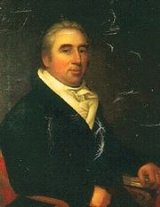
Marbury v. Madison
Overview
Judicial review in the United States
Judicial review in the United States refers to the power of a court to review the constitutionality of a statute or treaty, or to review an administrative regulation for consistency with either a statute, a treaty, or the Constitution itself....
under Article III
Article Three of the United States Constitution
Article Three of the United States Constitution establishes the judicial branch of the federal government. The judicial branch comprises the Supreme Court of the United States and lower courts as created by Congress.-Section 1: Federal courts:...
of the Constitution
United States Constitution
The Constitution of the United States is the supreme law of the United States of America. It is the framework for the organization of the United States government and for the relationship of the federal government with the states, citizens, and all people within the United States.The first three...
. It was also the first time in Western history a court invalidated a law by declaring it "unconstitutional
Constitutionality
Constitutionality is the condition of acting in accordance with an applicable constitution. Acts that are not in accordance with the rules laid down in the constitution are deemed to be ultra vires.-See also:*ultra vires*Company law*Constitutional law...
", a process called judicial review
Judicial review
Judicial review is the doctrine under which legislative and executive actions are subject to review by the judiciary. Specific courts with judicial review power must annul the acts of the state when it finds them incompatible with a higher authority...
. The landmark decision helped define the "checks and balances
Separation of powers
The separation of powers, often imprecisely used interchangeably with the trias politica principle, is a model for the governance of a state. The model was first developed in ancient Greece and came into widespread use by the Roman Republic as part of the unmodified Constitution of the Roman Republic...
" of the American form of government
Federal government of the United States
The federal government of the United States is the national government of the constitutional republic of fifty states that is the United States of America. The federal government comprises three distinct branches of government: a legislative, an executive and a judiciary. These branches and...
.
The case resulted from a petition to the Supreme Court
Supreme Court of the United States
The Supreme Court of the United States is the highest court in the United States. It has ultimate appellate jurisdiction over all state and federal courts, and original jurisdiction over a small range of cases...
by William Marbury
William Marbury
William Marbury was one of the famous "Midnight Judges". Due to President John Adams's work in the night before he was to leave office, Marbury was to be appointed a Justice of the Peace in the District of Columbia. He was appointed there to give the Federalists a stronghold in the judicial...
, who had been appointed by President John Adams
John Adams
John Adams was an American lawyer, statesman, diplomat and political theorist. A leading champion of independence in 1776, he was the second President of the United States...
as Justice of the Peace
Justice of the Peace
A justice of the peace is a puisne judicial officer elected or appointed by means of a commission to keep the peace. Depending on the jurisdiction, they might dispense summary justice or merely deal with local administrative applications in common law jurisdictions...
in the District of Columbia
Washington, D.C.
Washington, D.C., formally the District of Columbia and commonly referred to as Washington, "the District", or simply D.C., is the capital of the United States. On July 16, 1790, the United States Congress approved the creation of a permanent national capital as permitted by the U.S. Constitution....
but whose commission
Letters patent
Letters patent are a type of legal instrument in the form of a published written order issued by a monarch or president, generally granting an office, right, monopoly, title, or status to a person or corporation...
was not subsequently delivered.
Unanswered Questions

